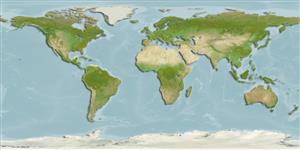Common names from other countries
Classification / Names / Names
Common names | Synonyms | Catalog of Fishes (gen., sp.) | ITIS | CoL | WoRMS
Environment: milieu / climate zone / depth range / distribution range
Ecology
Benthic; depth range 3 - 15 m (Ref. 2243). Subtropical
Western Central Atlantic and the Mediterranean.
Length at first maturity / Size / Weight / Age
Maturity: Lm ? range ? - ? cm Max length : 0.0 cm TL male/unsexed; (Ref. 2243)
Found in fine and medium to coarse sand with detritus mixed with gravel, in the sublittoral zone (Ref. 2243).
Todaro, M.A., M. Balsamo and P. Tongiorgi. 1992. (Ref. 2243)
IUCN Red List Status (Ref. 130435)
CITES status (Ref. 108899)
Not Evaluated
Not Evaluated
Human uses
| FishSource |
Tools
More information
Common namesSynonymsPredatorsReproductionMaturitySpawningFecundityEggsEgg development
Age/Size
Growth
Length-weight
Length-length
Morphology
Larvae
Abundance
Internet sources
Estimates based on models
Preferred temperature
(Ref.
115969): 17 - 20.7, mean 18.7 (based on 197 cells).
Vulnerability
Low vulnerability (10 of 100).
Price category
Unknown.
